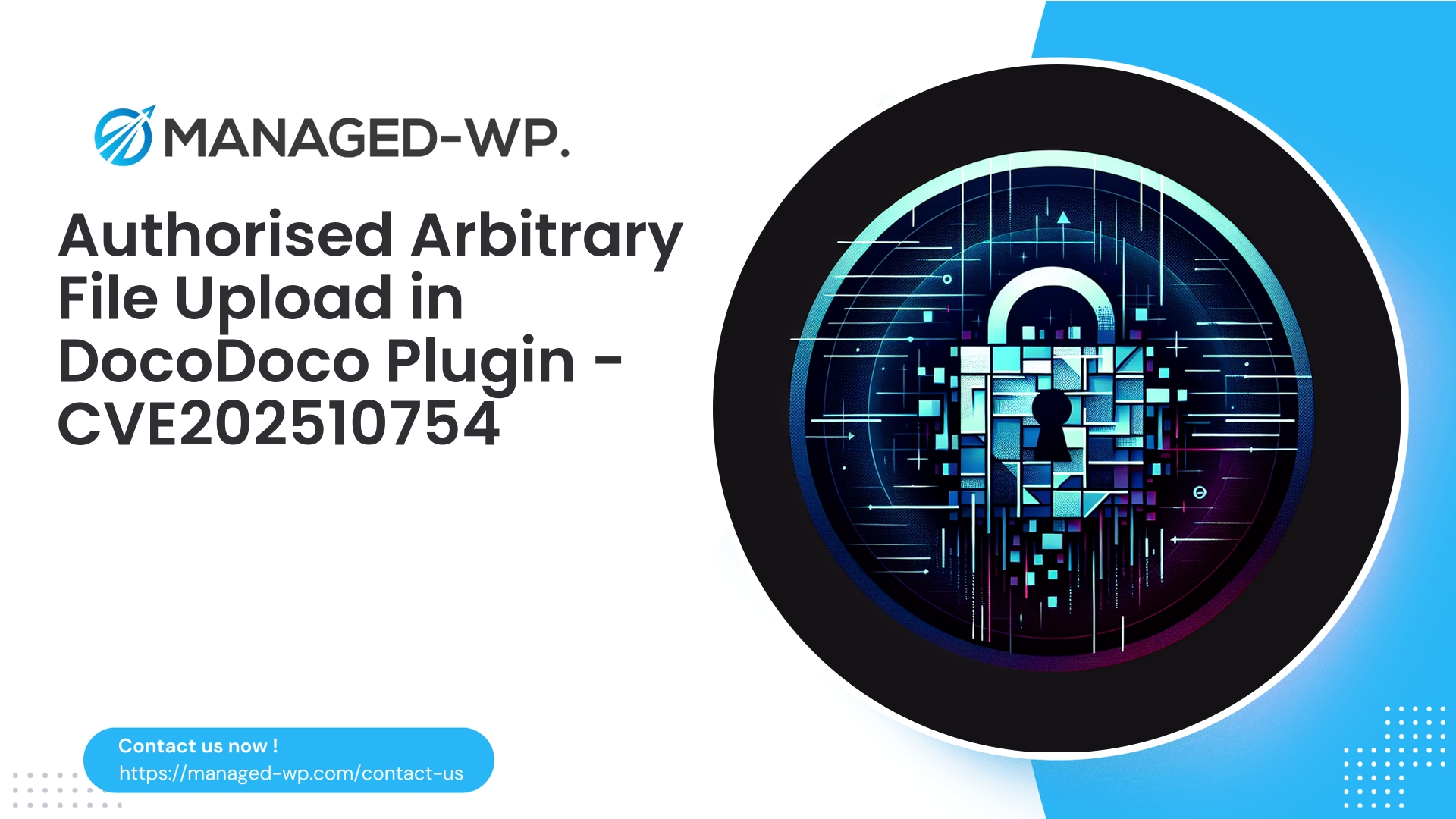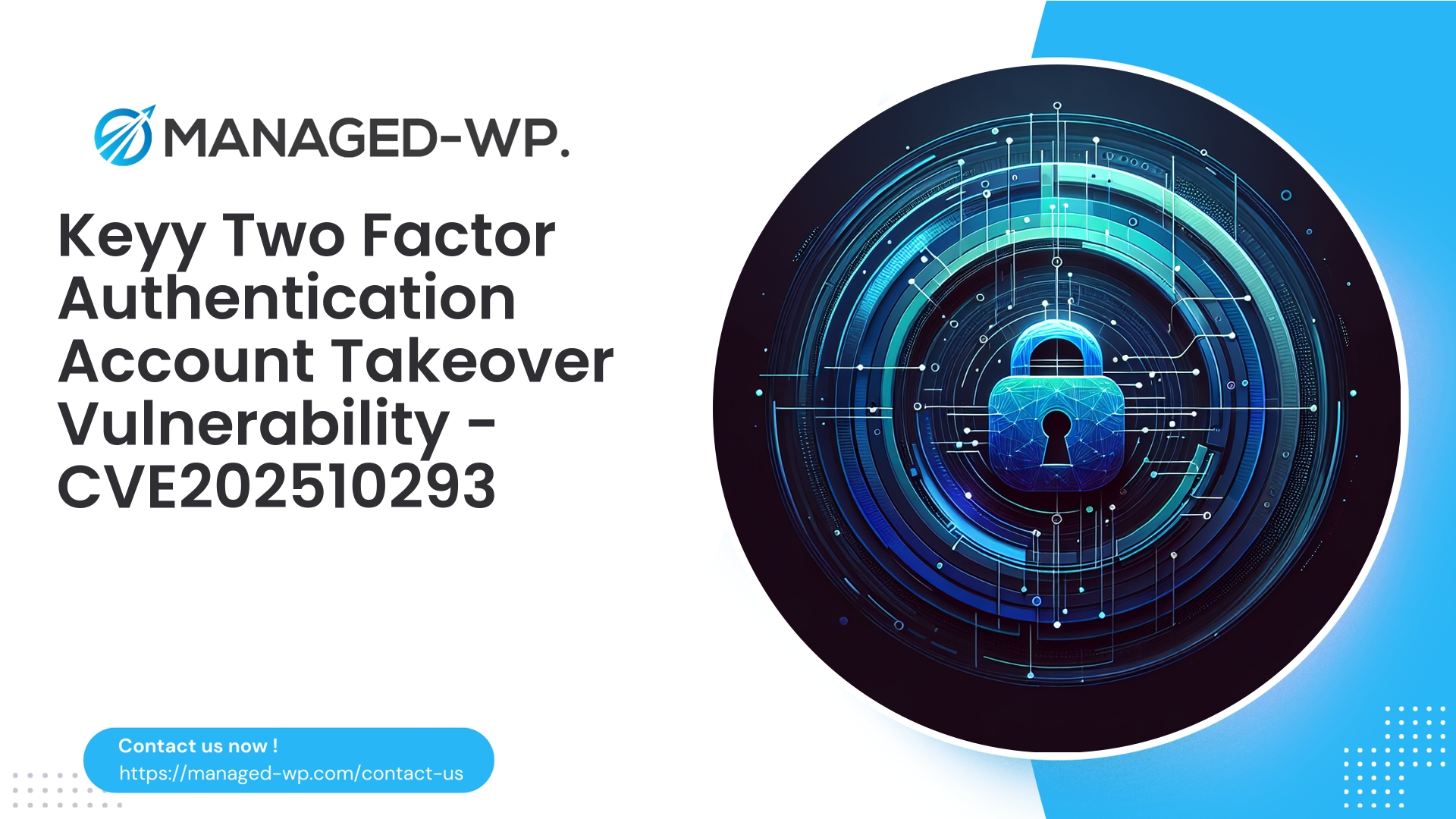| 插件名称 | DocoDoco 门店定位器 |
|---|---|
| 漏洞类型 | 已认证文件上传漏洞 |
| CVE编号 | CVE-2025-10754 |
| 紧急 | 高的 |
| CVE 发布日期 | 2025-10-15 |
| 源网址 | CVE-2025-10754 |
紧急安全公告:DocoDoco Store Locator(版本≤1.0.1)存在身份验证任意文件上传漏洞
日期: 2025年10月15日
作者: 托管 WordPress 安全团队
致 WordPress 网站所有者、代理商和开发者:DocoDoco Store Locator 插件 1.0.1 及更低版本存在严重漏洞 (CVE-2025-10754)。该漏洞允许拥有编辑权限或更高权限的已认证用户上传任意文件,从而可能实现远程代码执行。截至发稿时,插件供应商尚未发布官方补丁。
作为一家专注于 WordPress 安全防护的美国安全专家公司,Managed-WP 提供这份全面的风险分析报告,涵盖攻击手段、检测技术、修复策略和最佳加固实践。我们还重点介绍了部署 Web 应用防火墙 (WAF) 如何在这一脆弱时期提供关键保护。
本建议以清晰、专业的语言编写,并提供可操作的指导——如果您使用此插件,请仔细阅读并立即采取行动。
网站管理员执行摘要
- DocoDoco Store Locator 插件(≤ 1.0.1)包含一个经过身份验证的任意文件上传漏洞,具有编辑角色或更高角色的用户可以利用该漏洞。
- 拥有编辑器访问权限的攻击者可以上传恶意 PHP 文件(例如 webshell),从而实现对网站的完全控制,包括远程代码执行和数据窃取。
- 目前尚无厂商提供的修复方案。可立即采取的缓解措施包括移除或停用插件、限制编辑器上传权限、进行全面的文件扫描、轮换凭据以及部署基于WAF的虚拟补丁。
- Managed-WP 客户可以启用定制的 WAF 规则来阻止针对此插件的可疑上传尝试。
为什么这个漏洞至关重要
任意文件上传漏洞是内容管理系统 (CMS) 平台面临的最严重威胁之一,因为它们能够授予攻击者直接访问服务器的权限。主要问题包括:
- 执行恶意 PHP 后门或 webshell,从而实现对网站的完全控制。
- 使用双重扩展名或误导性文件名等文件混淆技术来逃避检测。
- 编辑角色权限通常足以上传和修改网站内容,从而造成很大的攻击面。
- 自动扫描程序极有可能针对未打补丁的网站进行扫描,从而呈指数级增加被攻击的风险。
尽管需要编辑级别的权限,但该漏洞仍能让攻击者完全控制网站。
利用步骤概述
- 攻击者通过窃取凭证、社会工程或其他手段获得编辑级访问权限。
- 他们利用插件的上传接口或 API 端点上传恶意文件。
- 由于缺乏适当的文件类型验证和存储路径保护,可执行文件可能会被上传到可通过网络访问的位置。
- 恶意载荷通过远程方式调用,从而可以执行任意命令或部署后门。
为了降低进一步的风险,我们不公开分享具体的漏洞利用代码;相反,我们专注于检测和缓解。
立即采取的事件响应行动
如果您的网站运行的是 DocoDoco Store Locator ≤ 1.0.1 版本,请立即执行以下步骤:
- 将您的网站置于维护或限制访问模式,以减少风险。
- 暂时停用或卸载该插件。如果无法立即移除,请重命名其目录以禁用代码执行:
通过 SSH 的示例:
sudo mv wp-content/plugins/docodoco-store-locator wp-content/plugins/docodoco-store-locator.disabled - 强制重置所有管理员和编辑帐户以及任何具有上传或发布权限的用户的密码。
- 撤销并重新颁发与该网站关联的所有 API 密钥或集成凭证。
- 轮换 WordPress 身份验证盐和密钥
wp-config.php使会话失效。 - 对……进行彻底扫描
wp-content/uploads以及其他可写目录,用于存放意外或可疑文件。 - 审核用户帐户,查找在此漏洞公开后创建的不熟悉的添加项;删除任何未经授权的用户。
- 检查是否存在对计划任务(wp-cron)、主题/插件文件的未经授权的修改,
.htaccess, 和wp-config.php. - 如果发现入侵迹象(例如 webshell 或后门),请立即隔离环境并寻求专业事件响应支持。
- 如果无法确定修复方案,请从已验证的干净备份中恢复。
Managed-WP 用户应在进行修复以减轻当前威胁时立即启用我们的虚拟修补 WAF 规则。
探测与搜寻技术
使用以下专为服务器环境定制的命令和检查方法,以识别入侵迹象或恶意上传:
扫描上传目录中的最近文件:
- 列出最近 30 天内修改过的文件:
查找 wp-content/uploads 文件,类型为 f,修改时间为 30 分钟,打印出 '%TY-%Tm-%Td %TT %p'
' | sort -r - 查找 PHP 或可疑扩展程序:
查找 wp-content/uploads 目录下的所有文件(-iname '*.php' -o -iname '*.phtml' -o -iname '*.php5' -o -iname '*.php7')并打印 - 查找包含 PHP 标签的文件:
grep -R --line-number --exclude-dir=cache --exclude-dir=logs ' - 识别具有双重扩展名或可执行后缀的文件:
查找 wp-content/uploads 文件 -type f -regextype posix-extended -regex '.*\.(php|phtml|php5|php7|phar|pl|py)$' -print
检查最近修改过的核心文件和主题/插件文件:
find . -type f -name '*.php' -mtime -30 -printf '%TY-%Tm-%Td %TT %p
' | sort -r
列出用户角色和注册信息(使用 WP-CLI):
wp 用户列表 --fields=ID,user_login,user_email,roles,user_registered
检查已激活的插件:
wp option get active_plugins
审查 .htaccess 对于可疑的规则或重定向:
tail -n 200 .htaccess
如果可能,请使用自动化恶意软件检测工具检查 PHP 文件中的 shell 签名和异常代码。隔离可疑文件,并从备份中恢复干净版本。
短期缓解措施
在等待官方补丁发布期间,请立即实施以下控制措施:
- 禁用或卸载该插件可阻止漏洞利用。
- 阻止在上传目录中执行可执行的 PHP 文件:
- 在 Apache 上,添加一个
.htaccess文件归档于wp-content/uploads和:否认一切
- 在 Nginx 服务器上,配置相应的 location 代码块以阻止 PHP 执行;如有必要,请咨询您的主机提供商。
- 在 Apache 上,添加一个
- 暂时移除
上传文件编辑角色所具备的功能:wp role remove-cap editor upload_files
请注意,这将降低编辑器的功能;请相应地通知内容团队。
- 在 WAF 或插件级别强制执行 MIME 类型限制和阻止可疑内容。
- 通过 WAF 规则阻止对插件特定上传端点的访问,限制为受信任的管理员或 IP 地址。
- 对所有上传文件启用严格检查,并监控日志以发现异常请求或上传失败尝试。
推荐的WAF规则概念
安全团队或托管WP运营商应考虑实施以下虚拟补丁规则:
- 阻止上传请求
/wp-content/plugins/docodoco-store-locator/*upload*除非来自管理员用户或受信任的 IP 地址列表。 - 拒绝包含 PHP 打开标签的文件上传(
<?php)或多部分请求中的混淆有效负载。 - 拒绝文件名包含双重扩展名或可执行文件后缀,这些后缀必须符合以下正则表达式模式:
/\.(php|phtml|phar|pl|py|exe|sh)$/i. - 强制执行严格的 MIME 类型嗅探,以确保声明的 MIME 类型与文件头匹配;阻止不匹配的情况。
- 阻止可疑用户代理或自动扫描器对易受攻击的插件端点进行重复上传尝试。
- 记录并分析异常的内容类型标头,例如:
应用程序/八位字节流发布到图像上传端点。
首先在检测模式下测试所有WAF规则,以进行校准并防止误报。与托管服务提供商协调,采取积极措施。
长期开发者修复
插件维护者和开发者应应用以下安全编码最佳实践来解决此类漏洞:
- 严格的能力检查: 使用
当前用户可以()具备相应的能力(例如,上传文件或者管理选项)授权上传操作。 - 随机数验证: 所有状态更改请求都必须通过以下方式验证 WordPress nonce:
wp_verify_nonce(). - 核心上传 API: 采用
wp_handle_upload()和wp_check_filetype_and_ext()利用 WordPress 内置的安全文件处理功能。 - 限制允许的文件类型: 限制接受的类型,只接受必要的类型(例如,图像),并验证扩展名和内容。
- 安全存储文件: 如果可能,请将上传文件保存在网站根目录之外,并通过安全代理或受控 URL 提供文件服务。
- 文件名清理: 使用以下方法移除不安全字符并防止目录遍历攻击
sanitize_file_name(). - 阻止执行: 配置服务器或
.htaccess阻止执行已上传的 PHP 或可执行文件的规则。 - 全面日志记录: 出于取证目的,跟踪用户操作和文件上传情况。
- 速率限制和反自动化: 对上传端点实施限制和 CAPTCHA 保护,以防止滥用。
- 安全测试: 实施自动化单元测试,以验证恶意载荷的拒绝情况并监控回归问题。
事故后清理清单
- 将网站置于维护状态,并创建完整备份(文件和数据库)以供取证审查。
- 隔离受影响区域,以防止持续损害。
- 按照排查程序识别恶意文件、未经授权的用户和篡改的代码。
- 从可信来源替换或重新安装任何已修改的核心、主题或插件文件。
- 删除未经授权的用户并使所有活动会话失效:
wp 用户会话销毁 - 重置所有管理员和编辑密码;更新外部凭据(FTP、主机、API)。
- 轮换认证盐和密钥
wp-config.php. - 清理后重新扫描环境。
- 如果从备份恢复,请验证备份是在入侵发生之前备份的,并立即实施加固措施。
- 监控日志和流量,以发现再次感染的迹象。
如有疑问,请联系专业的事件响应团队或主机安全专家。
监测与检测建议
- 启用登录事件、角色变更和文件上传的审计日志记录。
- 对插件、主题和上传目录实施文件完整性监控。
- 注意可疑的出站连接,这可能表明存在命令与控制通信。
- 在上传目录或其他可写目录中创建 PHP 文件时发出警报。
- 定期与已知的干净基线进行比较,以验证内容完整性。
虚拟补丁的重要性(WAF)
如果没有官方补丁,通过 Web 应用程序防火墙进行虚拟修补可以提供必要的临时防御:
- 实时阻止攻击尝试,大幅降低风险。
- 可立即部署,为补丁开发和测试争取时间。
- 避免直接修改易受攻击的插件代码,从而保持网站稳定性。
Managed-WP 强烈建议运行定制的 WAF 规则,重点关注上传端点、内容嗅探和已知漏洞利用途径——最初在监控模式下运行,然后再强制执行阻止。
纵深防御强化检查清单
- 如果不需要,请移除或禁用存在漏洞的插件。
- 应用 WAF 规则,针对可疑上传和插件特定端点。
- 阻止执行上传目录中的 PHP 代码和脚本。
- 暂时移除编辑角色上传功能的权限,直到补丁修复为止。
- 强制编辑和管理员重置密码。
- 轮换使用身份验证盐、密钥和外部凭据。
- 审核并启用审计日志记录。
- 仅使用可信赖的、最新版本的主题和插件。
- 定期进行经过测试的异地备份。
- 考虑对所有管理员/编辑帐户启用多因素身份验证。
基于场地暴露程度的风险优先级排序
- 高曝光度: 拥有多个编辑帐户、用户生成内容或高流量的网站必须立即采取行动——删除插件、启用 WAF 保护并进行彻底审核。
- 中等曝光: 拥有数量有限的可信编辑的网站可以与内容团队仔细协调补救措施,但不应拖延保护措施。
- 低曝光度: 即使是只有一个管理员的网站,也不应依赖看似较低的风险,必须采取必要的缓解措施。
面向开发人员的安全上传处理代码示例
以下是一个简化的示例,展示了安全上传的验证和处理。这只是一个概念性的起点,并非完整的解决方案。
false); $movefile = wp_handle_upload( $file, $overrides ); if ( isset( $movefile['error'] ) ) { wp_die( esc_html( $movefile['error'] ), '500' ); } // 可选:创建附件或自定义文章 // ... wp_redirect( wp_get_referer() ); exit; } ?>
团队沟通策略
- 请提醒内容团队注意,编辑人员可能暂时无法上传文件。
- 规划插件移除或更新的维护窗口,以最大程度地减少对运营的影响。
- 及时向利益相关者通报补救进展和任何事件调查结果。
Managed-WP:为您的 WordPress 网站提供即时、多层防御
对于寻求快速、一劳永逸的保护以进行修复的组织而言,Managed-WP 提供强大的 Web 应用程序防火墙解决方案,提供虚拟补丁、持续监控和威胁拦截——免费入门级计划可提供基本保护。
立即启用此自动防护层,即可阻止恶意上传、扫描 OWASP Top 10 威胁,并在主动修复漏洞的同时保持正常运行时间。了解更多信息并在此处注册: https://my.wp-firewall.com/buy/wp-firewall-free-plan/
(高级套餐包含自动恶意软件清除、高级 IP 过滤和详细的月度安全报告等功能。)
最终建议(按优先顺序排列)
- 立即移除或禁用存在漏洞的 DocoDoco 门店定位器插件。
- 启用 Managed-WP WAF 虚拟修补规则,以阻止针对此插件的攻击尝试。
- 扫描上传文件和其他可写目录,查找可疑文件并及时修复。
- 轮换所有凭证,强制使用强密码,并为管理员/编辑帐户启用多因素身份验证。
- 只有在漏洞完全修复且网站完整性得到确认后,才能恢复编辑器上传功能。
- 订阅 Managed-WP 漏洞警报和补丁通知,抢占先机。
我们随时为您提供支持
如果您是 Managed-WP 的客户,请联系我们的安全团队,立即部署针对此漏洞的精细化虚拟补丁,以阻止利用该漏洞的攻击。还不是我们的客户?注册我们的免费计划,即可在修复期间获得至关重要的保护: https://my.wp-firewall.com/buy/wp-firewall-free-plan/
记住:攻击者会自动化利用公开漏洞。迅速行动才是最有效的防御手段。
— Managed-WP 安全团队



















